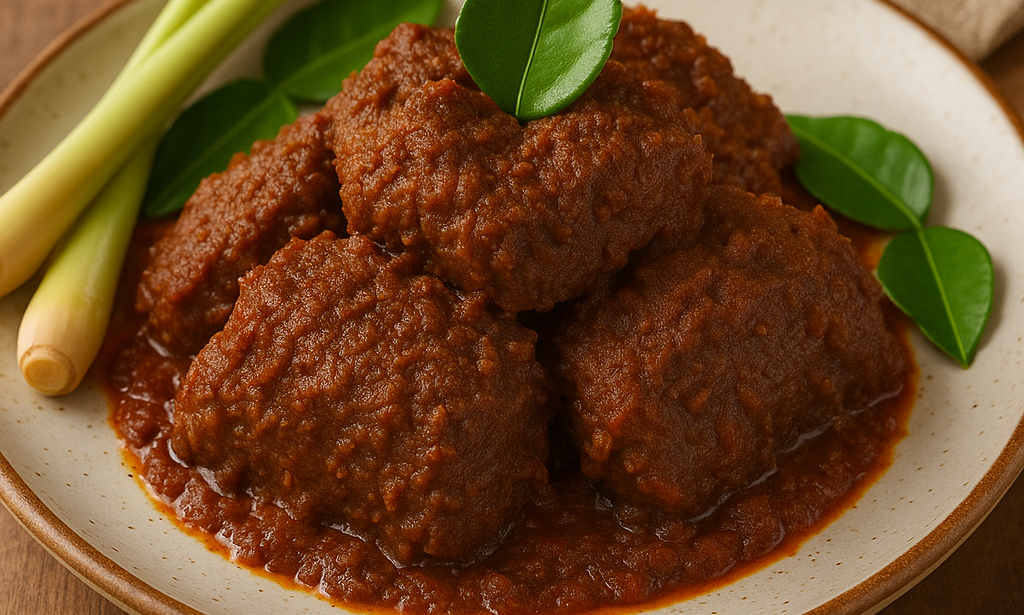Rendang Padang: Indonesia’s Most Beloved Beef Dish and Its Cultural Roots
Rendang Padang is not just food—it’s history, heritage, and heart on a plate. Originating from the Minangkabau ethnic group in West Sumatra, this world-famous Indonesian dish is celebrated for its rich flavor, tender texture, and slow-cooked mastery. Rendang is widely considered one of the most delicious dishes in the world, and for good reason.

🏺 Origins and Cultural Significance
More than a culinary delight, rendang holds deep cultural importance in Minangkabau society. Traditionally served during ceremonial events, such as weddings, family gatherings, and religious festivals, it symbolizes honor, patience, and community spirit.
The long, careful cooking process reflects the Minangkabau values of respect and dedication. Each stage of rendang’s preparation is a tribute to tradition, often passed down through generations. It’s a dish made not in haste, but with intention and care.
🧄 Ingredients and Preparation
Rendang Padang starts with beef—usually shank or chuck, chosen for their ability to become tender during long cooking. The meat is slow-cooked in a rich mixture of coconut milk and ground spices until deeply caramelized and dark brown.
✨ Key Ingredients:
-
Beef (shank or chuck)
-
Coconut milk
-
Lemongrass
-
Galangal
-
Garlic
-
Shallots
-
Ginger
-
Turmeric
-
Red chili peppers
-
Kaffir lime leaves
-
Salt and traditional seasonings
🍳 Cooking Method
-
Blending the spices: Garlic, shallots, chilies, ginger, and galangal are ground into a spice paste.
-
Simmering: The beef is added to coconut milk along with the spice paste, lemongrass, and lime leaves.
-
Slow cooking: The mixture is simmered over low heat for several hours. The liquid gradually evaporates, and the oil from the coconut milk begins to fry the spices.
-
Caramelizing: As the sauce thickens and darkens, the beef becomes tender, rich, and fully infused with flavor.
The final product is a dry, rich, deeply spiced beef dish that can be stored for days—or even weeks—thanks to its low moisture content and natural preservation through spices.
🌍 International Recognition
In 2011, CNN named Rendang the #1 dish in its list of the “World’s 50 Most Delicious Foods.” This global recognition brought attention not only to Rendang itself but also to the richness of Indonesian cuisine as a whole.
Since then, rendang has made its way into international cookbooks, restaurants, and culinary competitions. It stands as a proud ambassador of Indonesia's diverse and flavorful food culture.
🔄 Variations Across Regions
While Padang rendang is known for its dry texture and concentrated flavor, other Indonesian regions prepare it differently:
-
Kalio Rendang – a wetter, saucier version served before the sauce fully reduces.
-
Rendang Ayam – made with chicken instead of beef.
-
Vegetarian or jackfruit rendang – modern variations that cater to changing dietary preferences.
However, it’s the Padang version—dark, dry, and intense—that remains the most iconic and widely respected.
🎯 Conclusion: A Taste of Heritage
Rendang Padang is more than a meal—it’s a living story of tradition, patience, and pride. It connects people to their ancestors, celebrates milestones, and reminds us that food can carry emotion, memory, and meaning.
Whether enjoyed at home or in a traditional rumah makan Padang, rendang invites you to experience the depth of Indonesian culture with every bite. Its boldness, warmth, and authenticity are what make it not just food—but a treasure.
📌 Bonus: Did You Know?
-
In Minangkabau philosophy, rendang reflects four essential values: patience, wisdom, perseverance, and humility.
-
Rendang is often the last dish served during ceremonies—marking the height of celebration and hospitality.
Would you like this turned into:
-
A printable recipe card
-
A video script for YouTube
-
A carousel post for Instagram
Let me know and I’ll prepare the format you need!

lezat...dan gurih
You must be logged in to post a comment.